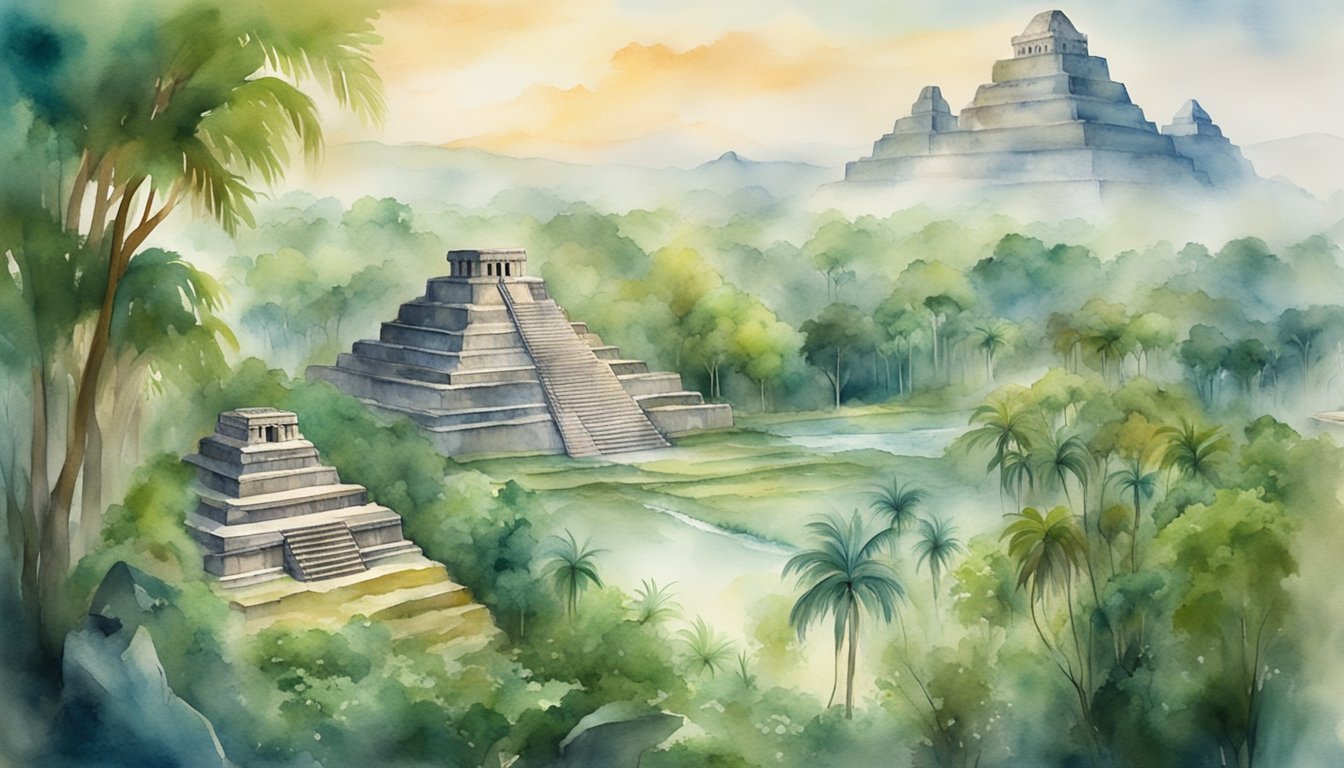Foundations of the Maya Civilization

Geographical Spread and City-States
The Maya civilization was a prominent Mesoamerican civilization that spanned modern-day Mexico, Guatemala, Belize, Honduras, and El Salvador1. At its peak, the civilization was scattered across the Yucatán Peninsula, Chiapas, Guatemalan Highlands, Petén region, and Verapaz2. Cities like Tikal, Uaxactún, and Copán were among its most important city-states3.
The origins of the ancient Maya can be traced back to the Archaic Period, which evolved into the Preclassic Period (2000 BC – 250 AD)4. Their civilization coexisted with the Olmecs, another influential Mesoamerican culture.
Cultural and Scientific Achievements
The Maya civilization was renowned for its remarkable advancements in various fields. They possessed a sophisticated writing system called the Maya script, which was the most advanced in pre-Columbian Americas. Additionally, the Maya were innovative in their art, architecture, mathematics, calendar, and astronomical systems5.
Some of their most notable architectural achievements include the construction of grand temples, public plazas, and intricate artworks adorning their buildings6. The Maya also made significant strides in the fields of mathematics and astronomy, accurately predicting the positions of celestial bodies and using a vigesimal numbering system7.
Religion and Cosmology
Religion played a central role in Maya civilization and their cosmology. The ancient Maya believed in a complex pantheon of gods and goddesses, including the creator deity, Itzamná, the rain god, Chaac, and the maize god, Hun Nal Ye8. The Maya’s religious beliefs often guided their day-to-day activities and ceremonies.
Their cosmology and religion were closely connected to their advanced knowledge of astronomy9. The Maya observed celestial phenomena and aligned their cities and temples with the movements of the stars and planets. By doing so, they believed they were maintaining a strong connection with the divine.
The foundations of the Maya civilization were built upon a rich tapestry of culture, science, and belief systems. Their impact on Mesoamerican history and their architectural and scientific achievements continue to captivate audiences worldwide.
Decline and Legacy
The Collapse of Maya Society
During the Classic period, the Maya civilization flourished with around 40 cities, including well-known sites like Calakmul, Tikal, Palenque, Copán, Uxmal, Chichen Itza, Bonampak and Dos Pilas. However, around the 9th century AD, the Classic period saw a significant decline, leading to the abandonment of many great cities.
Several factors contributed to the collapse of Maya society. One of the key factors was drought, which was potentially worsened by deforestation. As the population grew, there was an increased need for resources like farmland and timber, causing a strain on the environment and exacerbating the problems caused by climate change. Political unrest, warfare, and trade disruptions were also factors in the decline.
Spanish Conquest and Aftermath
During the Post-Classic period, the Maya civilization was fragmented into smaller city-states. Notable cities during this time included Mayapan, located in the Yucatán, that had strong ties with other powerful city-states like Chichen Itza. This period saw increased interaction and trade with other Mesoamerican cultures, including the Aztec empire based in Tula.
However, the arrival of the Spanish in the 16th century marked the beginning of the end for the remaining Maya cities. Through conquest and the spread of diseases, the Spanish managed to subdue the vast majority of the Maya population. Their culture, knowledge, and language were forcibly suppressed, leading to the destruction of many historical sites and artifacts.
Modern-Day Influence and Study
In modern times, the study of the Maya civilization has continued to captivate archaeologists and historians. The rediscovery of ancient Maya cities and the decoding of their hieroglyphic writing system have shed light on their history, culture, and technological achievements.
Today, the Maya people still live in areas throughout Central America, primarily in Guatemala, Belize, and southern Mexico. Their cultural legacy remains strong in the form of language, rituals, and customs that have been passed down through generations.
The history and legacy of the Maya civilization serve as a cautionary tale regarding the potential consequences of overpopulation and environmental exploitation. Additionally, the ongoing study of this ancient civilization provides valuable insights into the resilience and adaptability of human societies.

